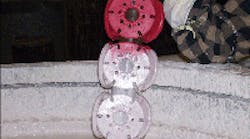Although it is one of the world’s oldest metalcasting technologies, investment casting (sometimes known as “lost wax” casting) has been subjected to a few misconceptions in recent years. Ironically, these misconceptions probably have caused many people who could have benefited most from this process to rule it out.
“People seem to misunderstand some of the distinguishing points about investment casting that make it an ideal practice for making certain parts,” says Tom Mitterbach, a sales rep and fabrication consultant for Gabriel & Associates, Huntsville, AL.
Mitterbach, who cut his teeth in the industrial steel foundry and forging markets of western Pennsylvania and northern Ohio, says that the truth behind the misconceived notions about the investment casting practice are saving his customers time and money.
His customers enjoy cost savings when productivity increases by enabling them to eliminate machining and production time in the construction of parts that would be difficult to produce through any other casting practice.
Not for casting iron?
Possibly one of the most basic misunderstandings about investment casting is that it is used principally to cast iron parts.
“This is pretty incongruous when you think about it,” Mitterbach says. “Although you can use the process for iron, we use it for just about everything but iron. The parts that we are selling range from 1 to 10 lbs. on average, however, the foundry can produce parts from an once or less and up to 50 lbs. Those who think of this process for cast iron pieces just don’t understand the basic technology.”
Investment casting is the precision casting of metal shapes using several steps, using a heat-disposable pattern by injecting wax into a metal die. When the assembly is heated, the wax escapes through openings in the outer mold, leaving a cavity into which the molten metal is poured.
Mitterbach adds that Rimer Enterprises, Waterville, OH, a state-of-the-art investment-casting specialist and one of Gabriel & Associates primary suppliers, does not even offer cast iron products. Although Rimer serves a variety of industries ranging from railroad to food processing, most of the pieces they cast are composed of carbon steels, stainless steels, bronze, brass or aluminum.
Precision is no problem
Often manufacturers are unaware that investment casting is appropriate for the formation of intricate metal parts.
“The detail you get from investment cast parts is pretty amazing,” Mitterbach says. “My great uncle was a sculptor in Atlanta years ago. He created President Carter’s inaugural seal by first carving it in wax, which was then investment cast. The wax sculpture included very fine details that were held in the cast medallion, the hair, eyes, and even the eye lashes. So, it is possible to get incredible detail and close tolerances from an investment casting. You get a part with as much detail as you want to put into it.”
Tom Balding, president of Tom Balding Bits & Spurs, Sheridan, WY, makes a line of equestrian gear, including bits and spurs as well as related jewelry and other metal accessory items.
“We have had several of these items investment cast for the last 10 years,” Balding says. “Many of those items are cast of mild steel or 304-grade stainless. Rimer is the only supplier we’ve used for the investment casting and they have always got good quality and service.”
Mitterbach adds that many people have had their first and perhaps only experience with investment casting in art classes.
“The very nature of artwork such as carvings is well suited to this form of casting because the artist wants faithful detail,” he says. “Plus, using this technology you can make a very limited number of items at a fairly reasonable price.”
Not the same as sand casting
“People unfamiliar with investment casting may be prone to compare it with green sand casting,” Mitterbach explains. “But most sand casting requires both a positive and negative mold, the cope and the drag. Unlike standard cope-and-drag sand molding practices, an investment-cast finished part is a positive reproduction made from a positive pattern.”
Investment casting is an ideal process for those who fabricate or use metal parts repetitively, whether intricate shapes or components that require precise tolerances. Also, some customers investment-cast parts in volumes of many thousands over years on an as-needed basis because turnaround time is relatively quick compared with typical sand molding of parts.
In the case of Tom Balding’s business, by investment casting he has been able to combine multi-piece parts bits to eliminate the need for welding and some finishing operations.
Machining
“Those who are unfamiliar with investment casting seem to assume that machining is a necessary step in finishing a cast metal part,” says Mitterbach. “That really is a myth. Machining costs additional time, material, and money. If you can avoid it, then you’ve saved. Investment casting gives you a ‘near net’ piece, so you’ve saved on most of the costs related to machining.” Investment castings may still require some machining but much of the machining work can be eliminated. Rimer also has an in-house machine shop for machining their castings, and they can deliver castings that are machined in some cases.
Are investment cast parts defect prone?
Management at Rimer is quite familiar with this myth. The fact is, investment-cast parts often contain alloys that make the part much stronger. Also, if the part can be made into a single structure, rather than two or more, that can add strength and save money.
“The integrity of a part like a bit for a horse can be very significant,” Tom Balding says. “It is important that they have the strength, because if a part fails that could lead to a runaway horse which could cause a bad accident.”










